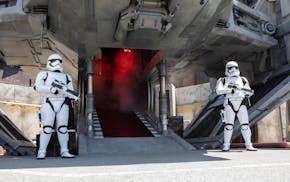Geoff Manaugh seems like a nice guy. He has a terrifically entertaining blog — bldgblog.com — that explores the mingling of architecture, technology and landscape. He also likes true-crime stories, which helps explain the distinctive purr in his writing, the kind that Edward G. Robinson brought to the big screen. The subject of "A Burglar's Guide to the City," fittingly, is burglary, and Manaugh is the brains of the operation. See?
Manaugh starts by turning the reader into a burglar. (Good burglars, the kind who get away, need read no further; bad burglars, the kind who get caught, pay heed there in your cell.) First he removes your eyes, then he unplugs your brain's circuitry. No worries — he outfits you with new eyes and rewires your brain to operate as it should, should you wish to burgle.
Burglary is a state-specific and murky crime. Overridingly, to burgle, you must break the close. "Breaking the close means crossing the outer limits of a space, whether it be the private interior of a home or the inside of a parked car." The FBI, never big on existentialism, calls burglary "the unlawful entry of a structure to commit a felony or theft," to include "apartment, barn, house trailer or houseboat when used as a permanent dwelling, office, railroad car (but not automobile), stable, and vessel." Mostly we're talking architecture, but note that discrepancy between cars in the definitions. Murky.
Don't call this a how-to guide. That's dicey for Manaugh. But, let us be real, it is; specifically, a how-to-get-into-a-burglar's-head guide. It is a psycho-geography of Asger Jorn and Guy Debord's Situationist ilk, imbibing a locale's ambience while questioning "the world's most basic spatial assumptions … to think past the tyranny of architecture's long-held behavioral expectations." Said Harry Houdini, a burglar is someone "uniquely attuned to the rhythms of the streets."
What Manaugh teaches you — and it is a barrel of fun, at remove — is that the art of burglary is in finding a building's surprises. It once was called casing the joint. "They could simply walk inside — but no." They rappel through the skylight, find the secret stairways.
The city's underground is their highway. They mimic the city's camouflage, jam the authorities' gizmos. They are architecture's deviant counternarrative. In that, they break the social contract.
Here comes the bucket of cold water. "They wreck the lives and security of others for as little as a necklace," leave abiding emotional wounds, reminds Manaugh. Neither tricksters nor rapscallions, they perpetrate "a very heinous offense," wrote 18th-century barrister Sir William Blackwell, "as it is a forcible invasion and disturbance of the right of habitation … even in a state of nature; an invasion, which, in such a state, would be sure to be punished with death."
So it goes, sadly all around: second-story work, Second Amendment response. Bang!
Peter Lewis is book review editor of Geographical Review and former director of the American Geographical Society.
Jerry Seinfeld's commitment to the bit
Music Review: Anitta welcomes listeners into her 'Funk Generation' on new album
Ask Amy: Give up on estranged brother


